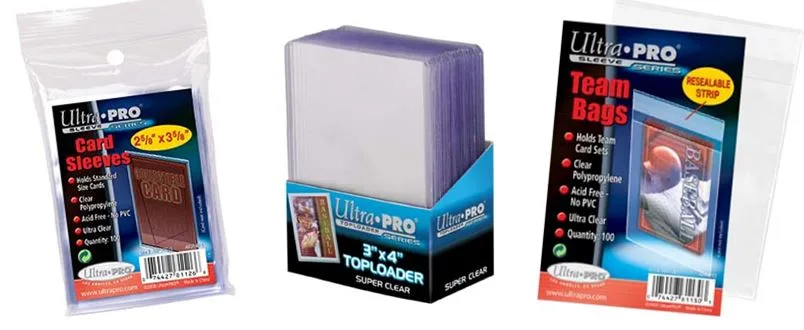Inside the Pack: How to Protect when You’re Collecting
There are a lot of supplies out there for sports card collectors to consider. While some are better than others, they each serve a unique purpose, and it can sometimes be difficult to navigate the world of supplies. To help in that regard, I’ve compiled this list of supplies and how and when to use them appropriately.
Binders with 9-pocket pages are for folks who want to look at their cards often. This setup is most typically used in conjunction with complete sets, allowing the owner to flip through the pages. Binder pages offer precious little protection to cards, though, and can sometimes warp or stick to the cards in certain temperature conditions. So, it’s best to stick with lower-end base cards here, or use carefully-selected binder pages in a controlled environment for more expensive vintage cards.
Plastic cases come in a range of options; some have a hinged top, while others are two separate pieces that slide into one another. These cases usually hold anywhere from 10 to 200 individual cards. Beware that cards can move around in these cases, and if the case is not nearly filled to capacity, you could damage corners. Buy an accurate size case to prevent movement.
Cardboard boxes are a great way to store a large number of cards. But it’s important to recognize that boxes are designed to have extra room and them and cards do not fit flush against the sides. If your boxes are just staying in one place and don’t contain valuable cards, you can get away without further protection. But if you have more expensive cards or plan to move your box around (to and from a card show or your friend’s house, for example), you’ll want an added layer of protection.
When using a one-piece cardboard box (usually 930 count or less), you’ll want to use penny sleeves, also known as soft sleeves or just card sleeves. These flexible plastic sleeves fit somewhat snugly around a card and give the card an extra barrier against ailments like corner dings.
You can also use penny sleeves in a two-piece cardboard box (usually 800 count or more, up to 5000 count), but these boxes have more height and width available to you in the rows, so you can also use a hard outer case as well. There are several options of harder cases.
The least protective of these is a semi-rigid holder, also known by its brand name Card Saver. These provide some level of protection while having the benefit of weighing less in bulk and being cheaper to buy. Another benefit is because they have some flexibility to them, thicker cards can fit in the same holders you’d use for a thinner card. They come in multiple width sizes (as well as larger sizes for items like index cards and photos); the Card Saver I is wider than the Card Saver II and is therefore easier to work with. I prefer the wider ones for single cards as well, because the extra width makes it easier to slide cards in. If you’ve never used semi-rigids before, you will almost certainly damage a card trying to slide it into a Card Saver II, but will have better luck with a Card Saver I.
The most common case is a top loader. These come in a variety of styles, but the most important designation you need to be aware of is the thickness. You can use a thickness chart to determine how many points thick your card is, then purchase the corresponding size top loader. Standard cards use 35-point top loaders, but be aware there are special vintage card top loaders made for cards from 1952 to 1955, as well as small top loaders for tobacco cards.
Magnetic cases, also known by their brand name One Touch, are the upper echelon of single card protection. These run a few dollars each but offer maximum protection. The magnet on top enclosed your card inside the case, and the recess into which the card sits ensures that the card will not move around and get dinged. Like top loaders, these come in a variety of thicknesses, so be sure to check how many points thick your card is.
Regardless of which type of holder you choose, you can use a team bag to further secure your card and prevent it from sliding out, as well as prevent the holder from scratching. Team bags are a thin plastic bag with an adhesive closure and come in a variety of sizes; some fit snugly around a single top loader, while others are wider and can fit multiple top loaders inside. Still others, known as graded card sleeves, are taller and are intended to hold — you guessed it — graded cards. These can also be used to hold magnetic cases, which are taller than standard top loaders and therefore don’t fit into traditional team bags.
Whatever you use to protect your collection, make sure it’s meeting your needs. The value of sports and non-sports cards is highly dependent on condition, and keeping your cards in good shape should be of the utmost importance. Using the correct protection will help keep your collection organized and safe.




